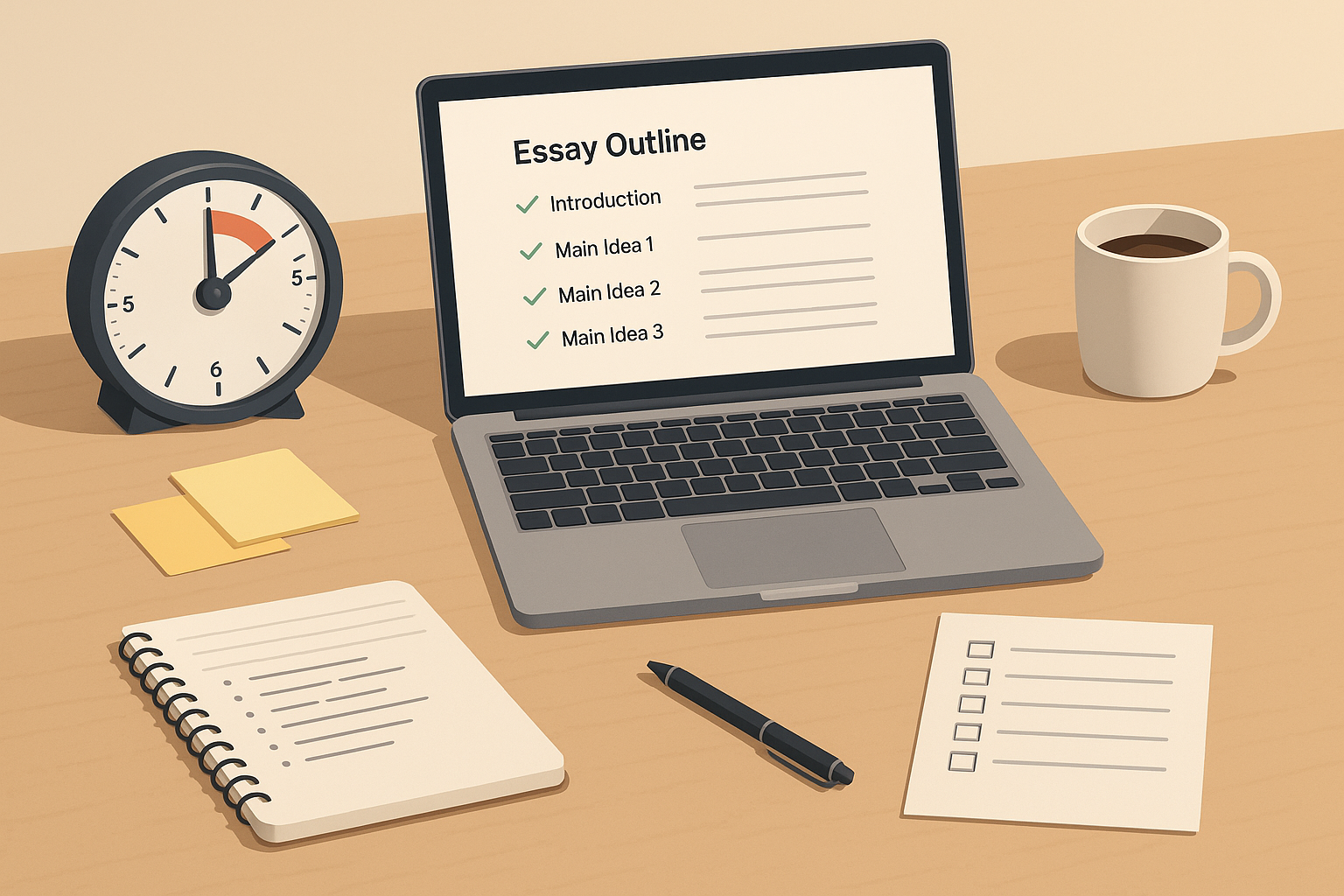Table of contents
Need to turn scattered notes into a polished, 1,500-word essay tonight? Use this streamlined, two-hour workflow: clarify the prompt and thesis in minutes, time-box a skeletal outline, draft fast with a repeatable paragraph formula, drop in evidence without stalling, then run a single high-impact editing pass for clarity, coherence, and formatting.
Prepare in 10 Minutes: Scope, Thesis, and Materials
Speed starts with ruthless focus. Before you write a single sentence, invest a brief, high-leverage setup that prevents detours later.
Clarify the task. Skim the assignment and extract the non-negotiables: required length, citation style, deliverables (e.g., title page, headings), and any verbs that imply structure—analyze, compare, evaluate, argue. Rephrase the prompt in one sentence you can keep in front of you. This guards you from drifting into a generic summary.
Define a one-sentence thesis. Your thesis is a testable claim, not a topic. A useful template: Although Counterpoint, this essay argues Claim because Reason 1 and Reason 2. Write it plainly now; you’ll elevate the phrasing later. The test: if a friend could disagree with it, you have a thesis. If not, it’s still a topic.
Bundle your materials. Put your notes, PDFs, and quotations in one document so you don’t tab-surf while drafting. Drop each source beneath a quick label (Author–Year or Short Title), paste the page numbers you’ll cite, and jot a 10-word reminder of what each source proves. The goal is zero hunting while drafting.
Set a word budget. For 1,500 words, aim for 150–180 words per paragraph across 8–10 body paragraphs, plus intro and conclusion. Knowing your budget makes it obvious when a section is bloated or underfed.
Decide on your structure. Most argumentative or analytical essays work with: Introduction → 3–4 sections with 2–3 paragraphs each → Conclusion. If the task is comparative, mirror the structure for A vs. B; if it’s thematic, sequence points as cause → effect → implication.
Build a Time-Boxed Outline (Without Over-Outlining)
Outlining is not writing; it’s pre-decision-making. Give yourself a strict ceiling—15 minutes—to map the logic, not the prose. Use the thesis to derive section claims and checkpoints of evidence.
Skeleton first. Draft 3–4 H2-level section claims (you’ll see them below as the major sections of this article). Under each, jot 2–3 sub-claims you can prove. Each sub-claim will become one paragraph. Make these sub-claims declarative sentences, not vague labels: e.g., instead of Education outcomes, write Early feedback loops double revision quality.
Place your best evidence on the path of least resistance. Next to each sub-claim, mark one supporting item: a statistic, a quotation, an observation, a brief case. Keep it to a single bullet or inline note. If you have multiple pieces of evidence, choose the one that most directly proves the sub-claim; extras can be promoted to a sidebar sentence or cut.
Pre-write transitions. Add a one-line bridge for each section: Having shown X (cause), we can now see Y (effect). These microscopic transitions save minutes when moving between ideas and prevent the dreaded “Paragraph Cliff,” where momentum dies at section boundaries.
Lock the timeline. Commit to a two-hour plan. You’ll move faster knowing exactly when each stage must end.
| Stage | Objective | Time | Output |
|---|---|---|---|
| Setup | Clarify prompt, thesis, sources, word budget | 10 min | One-sentence prompt, thesis, labeled notes |
| Outline | Section claims, sub-claims, evidence map | 15 min | 3–4 sections, 8–10 paragraph notes |
| Draft | Produce 1,200–1,400 words of body text | 70 min | Complete body with citations/placeholders |
| Intro/Conclusion | Hook, context, restated thesis; implications | 10 min | Polished opening and closing |
| Edit | One pass: clarity, cohesion, formatting | 15 min | Clean 1,500-word essay, styled and consistent |
Why time boxes work: They convert “I should outline” into “I have 15 minutes to make choices.” Constraints create speed.
Draft Fast with the 5–7–10 Rule
The fastest way to 1,500 clean words is to write predictable paragraphs. The 5–7–10 Rule keeps each paragraph tight and purposeful:
-
5 sentences per paragraph (target range: 4–6).
-
7 minutes maximum per paragraph.
-
10 words or fewer for the paragraph’s topic sentence.
This constraint avoids two killers of speed: paragraph sprawl and perfection paralysis.
Paragraph Blueprint
-
Topic sentence (≤10 words). Make a clear claim: Peer feedback accelerates clarity.
-
Set-up sentence. Contextualize the claim: when/why it matters in this essay.
-
Evidence sentence. Quote, paraphrase, or summarize. Keep the citation short (Author–Year or [#]).
-
Analysis sentence. Interpret how the evidence proves the claim.
-
Link sentence. Tie to the thesis and preview the next step.
Write with verbal placeholders for anything that might slow you down: (insert page), (define term), (add figure). You’ll resolve these in the edit pass. The point now is momentum.
Manage Word Flow With Micro-Milestones
Every 15 minutes, aim for ~300 words. If you’re under, reduce sentence length and move on—don’t backfill forever. If you’re over, your paragraphs are bloating; cut the softest sentence and continue. Use the outline like rails: you’re following a track, not exploring a forest.
Introductions and Conclusions, Last
Draft the body first; it’s the high-leverage core. When the argument exists on the page, the introduction writes itself: start with a context hook, define the problem, state the thesis, preview the structure in one sentence. For the conclusion, avoid summary; aim for implication and next step: what changes if your thesis is true? What question remains open?
Pro tip for speed: Write the ugly version of a sentence immediately, then replace its weakest verb on the spot. Strong verbs reduce the need for adjectives and adverbs, compressing word count while increasing force.
Evidence and Citations Without Losing Speed
Evidence should lubricate drafting, not stall it. Your system from the setup phase lets you plug proof into paragraphs as you draft, then refine citations later.
Keep citation friction low. Use a consistent inline placeholder format—e.g., (Smith, 2022, p. 37) or (MLA: 37)—and move on. You will harmonize style (APA/MLA/Chicago) during editing. The goal is to keep thinking flowing; style polish is a separate task.
Integrate, don’t attach. A common time sink is dropping long quotes that need heavy framing. Prefer short, surgical quotations or paraphrases woven into your voice. Follow this three-move micro-pattern: introduce the source with why it’s credible, present the data in one clean clause, and interpret the implication in your own words. This eliminates the “quote sandwich” bloat.
Balance exposition and analysis. If a paragraph has two evidence sentences, it needs two analysis sentences. Aim for a 1:1 ratio so your voice stays primary. Remember: graders evaluate your reasoning more than your ability to copy facts.
Place figures and tables sparingly. If your argument hinges on a comparison (before/after, A vs. B), a simple table communicates faster than a paragraph. But every table must earn its space: it should reduce words while increasing clarity.
One-Pass Edit: Clarity, Flow, and Formatting
Editing is where speed becomes quality. With 15 minutes on the clock, you’ll get the highest return by focusing on readability, cohesion, and compliance—not sentence-level ornament.
Clarity: Shorten, Sharpen, Show
-
Shorten sentences. If a sentence has three commas, split it. Aim for an average of 15–18 words.
-
Sharpen verbs. Replace is/are/has/does with action: demonstrates, isolates, amplifies, challenges.
-
Show specifics. Swap vague nouns (factors, aspects, things) for named concepts that reflect your thesis.
Flow: Guide the Reader’s Attention
-
Front-load purpose. Begin sections with a sentence that states the task of that section in thesis terms.
-
Use topic strings. Reuse a key term from the prior paragraph in the next paragraph’s first clause to build continuity.
-
Elevate transitions. Replace empty bridges (Furthermore, Moreover) with cause-effect cues (As a result, Consequently, By contrast).
Formatting: Meet the Brief Exactly
-
Headings & spacing. Apply the required style (APA/MLA/Chicago) to headings, margins, line spacing, and page numbers.
-
Citations & references. Normalize your placeholders to the required style in one sweep. Check capitalization, italics, and hanging indents only once—batching saves time.
-
Consistency checks. Scan for numbering (1–9 vs. one–nine), quotation mark style, and hyphen/en-dash/em-dash usage. Uniformity boosts perceived quality.
A Minimal, High-Impact Table You Can Reuse
If your essay compares positions, texts, or time periods, this compact table scaffolds your analysis without bloating your word count. Adapt the labels to your topic during the draft or edit pass.
| Dimension | Position A | Position B | So what? (1-line insight) |
|---|---|---|---|
| Core claim | |||
| Best evidence | |||
| Weakest link | |||
| Consequence |
Populate it with fragments during drafting, then translate the most valuable row into a paragraph. This keeps the essay’s comparisons honest and crisp.
Bringing It All Together
If you follow the timeline and the 5–7–10 rule, a 1,500-word essay becomes a sequence of small, winnable tasks instead of a two-hour panic. You started by narrowing the target and drafting a plain thesis, built a skeletal outline that made decisions for you, wrote fast in predictable paragraph units, dropped in evidence without derailing momentum, and finished with a single, disciplined edit that brings coherence and compliance. This is the fastest path to a clean draft under pressure—and it’s repeatable.
If you’re facing a particularly high-stakes deadline, consider splitting the workflow across two shorter sessions: 40 minutes to set up and outline now, 80 minutes to draft and edit early tomorrow. The method survives context switches precisely because it’s modular. And once you’ve used it a few times, you’ll find your brain starts pre-building the outline while you’re still reading the prompt—the real secret to writing faster is deciding faster.
It is easy to check materials for uniqueness using our high-quality anti-plagiarism service.
Order now »

